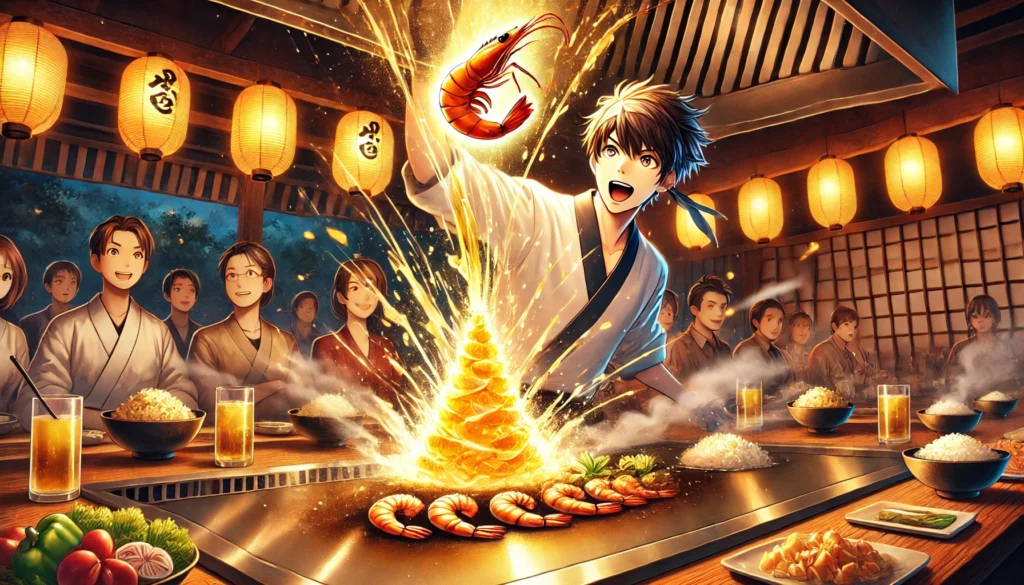The sizzle of marbled beef hitting a scorching iron griddle. The mesmerizing blur of knives as a chef transforms simple ingredients into culinary art. The communal joy of sharing an interactive meal where cooking becomes performance. This is teppanyaki – a Japanese cooking style that brings the kitchen directly to your table and turns dinner into theater.
With over 500,000 monthly searches in the United States alone, teppanyaki has clearly captivated American diners seeking both delicious food and memorable experiences. Yet many people still confuse this distinctive cooking method with other Japanese cuisines or have only experienced Americanized versions.
In this guide, we’ll explore what authentic teppanyaki truly is, its fascinating history, the theatrical techniques that define it, and how to appreciate this unique Japanese cooking style whether you’re at a high-end restaurant or attempting it at home.
Want to explore Japan’s culture?
Discover Japan’s rich culture, traditions, and hidden gems with our expertly crafted guides. Get insider tips on travel, food, and history. All for free!
What is Teppanyaki? Understanding the Basics
At its core, teppanyaki (鉄板焼き) combines two Japanese words: “teppan” (鉄板) meaning iron plate, and “yaki” (焼き) meaning grilled or cooked. This perfectly describes the cooking method – ingredients prepared on a flat iron griddle at high temperatures.
Unlike some Japanese cooking styles that emphasize subtlety, teppanyaki embraces bold flavors and visual excitement:
- Cooking occurs on a flat iron surface heated to extremely high temperatures
- Chefs prepare food directly in front of diners, often with theatrical flair
- Premium ingredients like high-grade beef, seafood, and fresh vegetables take center stage
- Simple seasonings highlight rather than mask natural flavors
- Communal dining experience creates social interaction among guests
What separates authentic teppanyaki from other grilling methods is the combination of premium ingredients, precise temperature control, and the interactive dining experience where the chef’s skills become part of the entertainment.
The Fascinating History of Teppanyaki
Teppanyaki‘s evolution reveals the fascinating cultural exchange between Japan and the West.
Japanese Origins and Western Influence
While grilling on iron plates existed in Japan for centuries, the modern teppanyaki restaurant concept began in 1945 when Shigeji Fujioka opened Misono in Kobe. Noticing that foreign visitors particularly enjoyed watching their food being cooked, the restaurant emphasized the performance aspect alongside the meal.
This evolved form of teppanyaki became immensely popular with American tourists, who appreciated the visual spectacle and familiar ingredients prepared with Japanese precision.
The American Teppanyaki Boom
Teppanyaki truly exploded in America when Hiroaki “Rocky” Aoki opened the first Benihana in New York City in 1964. Aoki brilliantly understood that Americans would embrace the theatrical cooking style, and he enhanced the performance elements that have now become synonymous with teppanyaki in the United States.
The popularity of teppanyaki continues to grow as diners seek experiences beyond just eating – they want memories, entertainment, and shareable moments alongside excellent food.

Authentic Teppanyaki vs. Western Adaptations
While many Americans are familiar with teppanyaki, what they’ve experienced is often an Americanized version that differs significantly from traditional Japanese practice.
Traditional Japanese Teppanyaki
In Japan, authentic teppanyaki focuses on:
- Superior ingredient quality above theatrical presentation
- Minimal seasoning (often just salt, pepper, soy sauce, and perhaps garlic)
- Precise cooking techniques that highlight natural flavors
- Elegant, restrained performance that emphasizes chef skill without gimmicks
- Allowing diners to savor each ingredient individually
Traditional Japanese teppanyaki chefs are judged primarily on their ability to perfect cooking temperatures and timing rather than performing tricks.
American-Style Teppanyaki
What many Americans experience as “teppanyaki” (often called “hibachi” in the US, though this is technically incorrect) typically features:
- Dramatic cooking performances with flaming onion “volcanoes”
- Utensil tricks and food tossed for guests to catch
- More heavily seasoned dishes with garlic butter, sweet sauces, and stronger flavors
- Fried rice cooked on the teppan (rarely done in traditional Japanese settings)
- Communal “dinner and a show” atmosphere
Both styles have their merits, but understanding the difference helps set appropriate expectations depending on your dining goals.
The Essential Elements of Teppanyaki Cooking
What makes teppanyaki distinct from other cooking methods comes down to several key elements:
The Teppan: Heart of the Experience
The iron griddle itself is central to teppanyaki and has specific characteristics:
- Extremely thick, high-quality steel that maintains even heat
- Typically heated to 425-450°F (218-232°C)
- Slightly sloped design with a grease trap
- Different temperature zones for cooking various items simultaneously
- Surrounded by a wooden or metal eating counter where guests are seated
This specialized equipment allows for the theatrical cooking style that defines the teppanyaki experience.
Premium Ingredients
Traditional teppanyaki emphasizes ingredient quality above all else:
- Wagyu beef (especially in high-end establishments)
- Fresh seafood like lobster, shrimp, and scallops
- Seasonal vegetables prepared to highlight natural flavors
- Simple starches like steamed rice (rather than the fried rice common in American versions)
The high heat of the teppan caramelizes proteins and creates complex flavors even with minimal seasoning.
Chef Performance and Interaction
The teppanyaki chef’s skills go far beyond just cooking:
- Knife techniques that combine precision with visual flair
- Spatial awareness to cook multiple items at different temperatures
- Timing coordination to ensure all diners’ food is ready simultaneously
- Social skills to engage with guests while maintaining focus on cooking
- Performance elements that enhance rather than distract from the meal
This combination of culinary and performance skills makes teppanyaki chefs among the most versatile in Japanese cuisine.

The Teppanyaki Dining Experience
When you visit a teppanyaki restaurant, understanding what to expect enhances your enjoyment:
Restaurant Setup
Most teppanyaki establishments feature:
- U-shaped seating around the teppan griddle
- Typically 8-12 guests per cooking station
- The chef working in the center within view of all diners
- Open kitchen concept where all preparation is visible
- Ventilation systems to manage the smoke from high-heat cooking
Typical Meal Progression
A standard teppanyaki meal follows this sequence:
- Appetizers – Often light dishes to stimulate the appetite
- Vegetables – Quickly cooked to maintain texture and flavor
- Seafood – Prepared with precision timing to prevent overcooking
- Meats – The highlight of most teppanyaki meals, especially premium beef
- Rice or noodles – Sometimes incorporates leftover flavors from the griddle
- Dessert – Typically served separately, not prepared on the teppan
Throughout this progression, the chef adjusts cooking techniques and timing for each ingredient while maintaining the theatrical element.
For more on Japanese dining customs you might encounter during your teppanyaki experience, our 100+ Essential Japanese Phrases guide includes useful expressions for restaurant settings.
Love Japan? Stay in the Loop!
Get the best of Japan straight to your inbox: language, culture & travel insights!
Preparing Teppanyaki at Home
While restaurant teppanyaki is difficult to fully replicate at home, you can capture many elements of this cooking style with the right equipment and techniques:
Essential Equipment
To create home teppanyaki, consider investing in:
- A high-quality electric griddle or stovetop griddle plate
- Metal spatulas and chopsticks for manipulation techniques
- Squeeze bottles for quick sauce application
- Small dishes for ingredient organization before cooking
- Heat-resistant cutting board for tableside preparation
Basic Teppanyaki Techniques
Master these fundamental skills for home teppanyaki:
- Temperature control – Different ingredients require specific heat levels
- Oil management – Using enough to prevent sticking without excess greasiness
- Ingredient timing – Coordinating cooking so everything finishes together
- Cutting techniques – Proper sizes allow for quick, even cooking
- Seasoning balance – Enhancing natural flavors without overwhelming them
If you’re interested in learning the Japanese numerical vocabulary useful for cooking measurements, our Counting to 100 in Japanese guide provides an excellent resource.
Popular Teppanyaki Dishes to Try
Whether dining out or cooking at home, these classic teppanyaki dishes showcase the cooking style’s versatility:
Protein Specialties
- Hibachi Steak – Typically New York strip or ribeye with simple seasoning
- Kobe/Wagyu Beef – The ultimate teppanyaki indulgence, often served with minimal accompaniments
- Garlic Shrimp – Quick-cooked to maintain tenderness with aromatic garlic butter
- Scallops – Seared to achieve perfect caramelization while maintaining a tender center
Vegetable Preparations
- Mushroom Medley – Assorted mushrooms cooked to enhance their natural umami
- Bean Sprout Stir-Fry – Quick-cooked for crispness with minimal seasoning
- Zucchini and Onion – Classic teppanyaki vegetables that absorb griddle flavors
Side Dishes
- Teppanyaki Rice – Simple steamed rice finished on the griddle
- Yakisoba – Stir-fried noodles cooked directly on the teppan
- Miso Soup – Traditional accompaniment (though prepared separately)
For those interested in the language behind these dishes, our Hiragana & Katakana Cheat Sheet helps decode Japanese menu terms.
Beyond Restaurants: The Cultural Impact of Teppanyaki
Teppanyaki‘s influence extends beyond restaurants into broader cultural significance:
Social Dining Revolution
The communal nature of teppanyaki dining helped popularize the concept of cooking as entertainment in America, influencing:
- Other interactive dining concepts like Korean BBQ and hot pot restaurants
- Open kitchen designs in non-Japanese restaurants
- Food as performance art in modern gastronomy
- The rise of chef’s tables and counter dining
Culinary Technique Adoption
Teppanyaki techniques have influenced modern cooking methods:
- Plancha cooking in Spanish cuisine
- Flat-top grilling in American diners
- Precision temperature control in contemporary kitchens
- Performance aspects of modern chef demonstrations
As we explored in our Japanese Food guide, the global influence of Japanese cooking techniques continues to reshape culinary landscapes worldwide.

FAQ: Teppanyaki Questions Answered
What’s the difference between teppanyaki and hibachi?
Teppanyaki uses a flat iron griddle, while traditional hibachi cooking uses an open-grate charcoal grill. In the United States, many restaurants incorrectly use “hibachi” to describe teppanyaki-style cooking, causing confusion between these distinct Japanese cooking methods.
Why is teppanyaki so popular outside Japan?
Teppanyaki combines delicious food with entertainment value, creating a memorable dining experience beyond just the meal itself. The interactive nature, where chefs cook directly in front of guests with theatrical flair, particularly appeals to Western diners seeking both sustenance and entertainment.
How long does a typical teppanyaki meal last?
A traditional teppanyaki dining experience typically lasts between 1.5 to 2 hours. This allows time for the chef’s performance, multiple courses prepared fresh, and a relaxed pace of eating that encourages social interaction among diners.
Is teppanyaki healthy?
Teppanyaki can be relatively healthy compared to many restaurant dining options. The cooking method uses minimal oil, focuses on fresh ingredients, and employs high-heat cooking that preserves nutrients. However, butter and oil usage in Americanized versions can increase caloric content.
Can vegetarians enjoy teppanyaki?
Yes, many teppanyaki restaurants offer vegetarian options featuring assorted vegetables, tofu, and sometimes meat alternatives cooked on a separate section of the grill. Always communicate dietary preferences when making reservations to ensure proper accommodation.
Conclusion: Embracing the Teppanyaki Experience
Teppanyaki represents the perfect marriage of culinary skill and entertainment, transforming dining into an interactive social experience. Whether you’re watching a master chef perform knife tricks at a high-end restaurant or creating your own teppanyaki feast at home, this cooking style offers a unique way to appreciate Japanese culinary traditions.
The continued popularity of teppanyaki in America speaks to our desire for more than just food when we dine out—we crave experiences, stories, and connections. At its heart, teppanyaki satisfies this hunger by bringing the kitchen directly to the table and making diners active participants rather than passive consumers.
Next time you find yourself seated around a sizzling iron griddle, take a moment to appreciate the centuries of tradition, cultural exchange, and culinary innovation that created the modern teppanyaki experience. Beyond the flying shrimp and flaming onions lies a cooking style that celebrates quality ingredients, precise technique, and the joy of shared meals.
For those interested in deepening their understanding of Japanese language and culture to enhance their teppanyaki experience, our JLPT N5 Kanji Cheat Sheet provides insight into basic written characters you might encounter on authentic menus.
What aspect of teppanyaki do you find most appealing? The theatrical performance, the interactive dining, or perhaps the delicious flavors? Share your experiences in the comments below!
Looking to explore more Japanese dining experiences? Check out our guides to Omakase and Food Near Me Sushi for other distinctive Japanese culinary adventures!
Join Fellow Japan Enthousiasts!
Ask questions, get study tips, and take part in weekly challenges. Join a community of motivated learners exploring both the language and culture of Japan!




